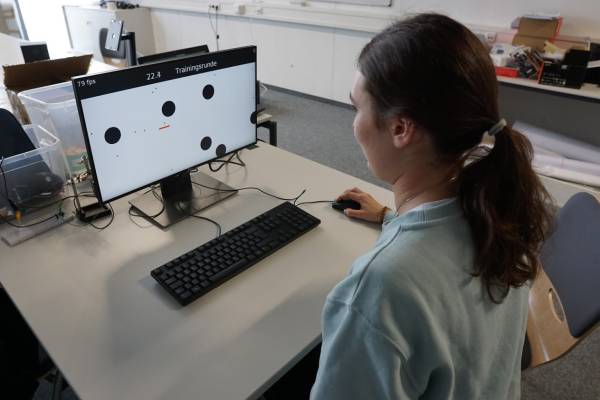Inhaltsverzeichnis
Influence of latency and latency variance on UX and performance
The influence of base latency on task performance and user experience while interacting with a computer system is a well researched topic. Yet, most components of a system do not provide a stable, but a fluctuating intensity of latency. It has not been researched how this variance is taking effect on the dimensions of performance and user experience. This is why we explore how latency and latency variance influence the performance and experience in the context of computer gaming. Before beginning study conception, we identified an adequate measuring method for the latency characteristics of our study prototypes. Next, a preliminary study with 30 participants was conducted using a custom low latency HID and a custom game prototype in order to explore valid parametrization ranges for base latency and latency variance. Based on the insights of the preliminary study, a more extensive main study was conducted, testing the influence of base latency and latency variance in the range of a Fitts’ Law-style game on 33 participants. We could establish the influence of base latency on player performance and the influence of high base latency on pleasure while playing. The results for different latency variances showed no differences, but may be influenced by limitations of our prototype: A setup based on open source and off-the-shelf components and software was chosen for higher replicability of the study, which came with a high end-to-end latency and a reduced the range of absolute latency variances.
 ?nolink&600 |}}
?nolink&600 |}}
Members: Vitus Maierhöfer, Felix Riedl, Andrea Fischer
Keywords: latency, latency variance, user experience, performance, user study
Background
While the influence of system latency in the context of HCI has been tested in an abundance of studies (e.g. Jota, 2013), there are still few insights of how varying latency may influence the way of interacting with a system. As shown by Bockes et. al. in 2018, many human input devices yet do vary in latency, reaching from small variances (e.g. a standard deviation in latency of 0.3ms for the Logitech RX250 mouse) to considerably high variances (e.g. a standard deviation of 4.9ms for the Gembird Mini keyboard). This aspect suggests that the usage of many digital interactive systems can not only come with a temporal offset between user input and recognizable system reaction, but also does this offset vary in size from event to event, depending on several aspects of the hardware setup.
We regard this fact as motivation for our study, which will explore how different permutations of latency and latency variance of digital interactive systems can affect the performance and user experience.
Goals
Answer the central questions of the project:
- How do different latency profiles (average latency and latency variance) influence performance?
- How do different latency profiles influence user experience?
- Which latency dimension has a stronger impact on which target dimension?
- Up to which level is latency variance acceptable?
Approach
- Literature Research
- Prestudy
- Preparation
- Pre-Pre-Study
- Evaluation and Adaptation
- Execution
- Evaluation
- Main Study
- Preparation, Test Run, Adaption
- Execution
- Evaluation
- Transcription
Updates
Impact of latency and latency variance on the uni life balance (2019-03-31)
This blog entry is a summary about the last semester and our work. (more...)
Writing the paper (2019-03-18)
This blog entry is about our paper with some extractions. Furthermore, our rebuttal letter and review approach is mentioned. (more...)
Related work (2019-02-18)
During our study, we read a lot of literature about latency. This blog entry provides a summary of our related work - with the goal to ease the process writing our paper. (more...)
Developing the Main Study Prototype (2019-02-16)
This article describes all aspects concerning the design of the study prototype. (more...)
The core of our research - the main study (2019-02-14)
Finally we conducted the main study. We conducted it on two places at the same time and splitted on two days. (more...)
Finalizing the main study (2019-02-11)
We parametrized the values for the main study and conducted the pre main study. Also we had several problems to solve. (more...)
Planning the MainStudy (2019-01-29)
A description about how we planned our MainStudy including the questionnaires and the lessons learned of the PreStudy. (more...)
How to interpret the videos of the PreStudy (2019-01-17)
creating an emotion metric for the video annotation (PreStudy). (more...)
Measuring end-to-end latency of the prestudy setup (2019-01-17)
This blog entry describes our way of measuring the end-to-end latency of the test setup of the prestudy. (more...)
"Pusher" - Constructing a latency-controllable HID-Prototype (2018-12-10)
In order to conduct a proper pre-study, the demand for a custom Human Interface Device has arisen during the early stages of the study design. A (more...)
Status Quo Prestudy (2018-11-27)
In order to explore the influence of latency and latency variance on performance and user experience, a simple prototype setup including a small game and a HID was developed. (more...)
Further Resources
…